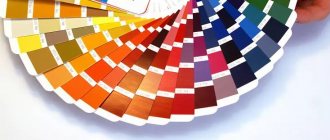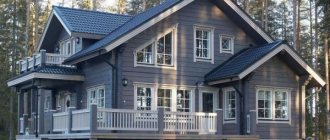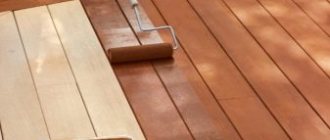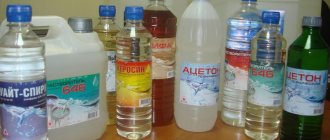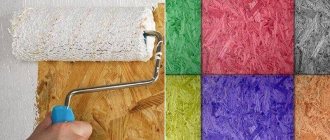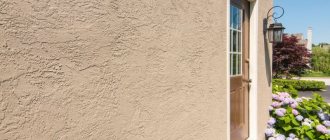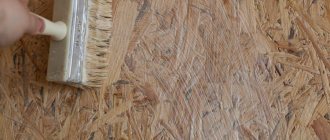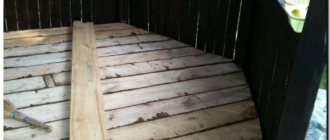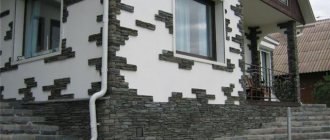Paints
Rating of the best wood paints for exterior use in 2021 buy. TOP 10
Paints
review of the best reviews. Rating of the best wood paints for exterior work in Russia list 2021 - 2021.
Paints
There is a reason why wood is in demand in the construction of buildings and parallel structures, such as bathhouses, gazebos and fences. This building material, in addition to looking elegant, is also very valuable due to its features. The wood is usually coated with varnish or paint. The latter will be discussed. This article presents the Rating of the best wood paints for exterior use for 2021.
Features of façade paint on wood
The process of painting houses built from wooden material differs only in that they require the use of special processing agents. The most important points that distinguish the usual technological process of painting a facade lie mainly in the preparatory work.
If the building is new, then before starting to prime the surface, it is treated with special solutions with anti-resin and antiseptic effects . This measure is necessary to prevent the release of resins from natural wood, as well as to provide additional protection to the wood from damage by insects and other pests.
As for the primer itself, the material is also chosen specifically for wooden surfaces. Otherwise, the entire process of painting a wooden house is quite simple. In addition, the process of painting a wooden house involves additional work to ensure the protective properties of the wall surface. Although there are also paints, using which there is no need to resort to any additional measures other than to complete the entire technological process.
CAREFULLY!
It is also very important to carry out the process of painting the facade of a wooden house in dry weather , and such weather conditions must persist for at least a week before starting work.
This is necessary so that the façade of the house does not carry excess moisture.
Oil paint
Oil paint has high adhesion to the surface. But it smells unpleasant and can give you a headache when painting. The smell does not disappear for a long time. Oil-based paints typically take a long time to dry. It is better to paint in dry weather. It quickly fades from ultraviolet radiation and changes its color. It is best to use a light-colored oil-based paint product. Its burnout is not so noticeable on it. It has a short service life of less than 7 years.
"Lacra MA-15"
The coloring composition is intended for external and internal use, for application to wooden and metal surfaces. To make the surface shiny and attractive, it is important to prepare it for painting: remove the old layer, remove uneven surfaces, and prime it. The composition is wear-resistant, forms a protective layer from external influences. It takes a long time to dry.
"Tikkurila teho"
Coloring agent that meets international quality standards.
- an important indicator of the coloring composition is its hiding power;
- it is intended for processing plank surfaces, fences, facades;
- high elasticity, strength contributes to paint durability, long service life of 7 years;
- The color palette is varied. It covers 120 colors and tones of the spectrum;
- It dries in 2-4 hours. When painting, it does not leave smudges.
"Teknos Wintol"
- high quality paint. Despite the high price, it is popular among buyers;
- does not discolor when exposed to sunlight;
- It is laid on the surface of the facade in an even layer, evenly distributed over it. Specialists from construction companies use a product for painting premium surfaces;
- the product does not change its properties under the influence of precipitation and temperature changes.
- The 30-year warranty and positive reviews about it allow you to be convinced of its reliability. Manufacturer: Finland.
Advantages and disadvantages
Regarding the advantages that can be obtained from the use of paints and varnishes for finishing the facade of a wooden house, the following can be identified:
- The most important thing is to create an attractive appearance of the building (including the old covering) and the opportunity to implement the most diverse and original ideas for decorating your home. The choice of such materials on the construction market is very large, and allows you to purchase the desired type of paint;
- the materials have a high level of covering power and, when applied, create a dense and elastic layer;
- the color rendering of paints and varnishes is very good, characterized by richness and clear texture;
- after applying paints and varnishes intended for treating wooden surfaces, the façade of the house does not lose its breathable properties;
- a dried layer of paint provides protection to the structure not only from unexpected mechanical damage, but also prevents cracks from forming in the wood;
- The protective coating can prevent the accumulation of dirt particles , which greatly facilitates the process of maintaining the building.
For such materials, there are some disadvantages that depend on the component composition of some paints. Most materials have a high level of toxicity, so they are only allowed to be used in open areas . The price category of materials is quite high.
In addition, some types of paints are not able to maintain their original color for a long time; they darken or fade. However, the manufacturers of such materials have provided for this and a high-quality paint coating requires re-coating the building with paint.
Advantages and disadvantages: consumer reviews
According to all consumer reviews, water-based facade paints have many advantages, these are:
Against the background of such advantages of “water-based emulsion”, there are practically no disadvantages, except for the impossibility of painting metal surfaces. And driven by demand, a large number of handicraft fakes. You should only purchase paint from well-known manufacturers in specialized stores.
Material properties
Materials intended for outdoor woodwork have certain properties that ensure a high level of quality:
- The materials help remove excess moisture , after which they provide a protective barrier that does not allow moisture to enter the wood structure.
- Paints help protect wooden surfaces from aging.
- The layer of material forms a special film that does not allow ultraviolet rays to destroy the structure of the wood , and also gives the wood strength, which allows cracks to not appear for as long as possible.
- After treatment with paints, the wood texture becomes more pronounced and attractive . This occurs due to the fact that the material penetrates into the smallest textured recesses in the wood and makes them more noticeable.
- Gives the facade of the building an attractive and aesthetic appearance.
Water-based paint, its properties, in what cases it is used for wood
Repair work and construction are the main areas of application of water-dispersed compositions. The compound H2O, known to everyone from chemistry lessons, is the basis of water-soluble dyes, to which pigments and some other binding components are added. They are necessary for better adhesion (adhesion) to the surface being painted and obtaining an even protective layer.
The wood dries after processing. The molecules of the main component of the paint replace natural water molecules:
- when painting tree bark with water-based paint;
- in finished products when coloring the characteristic wood texture.
This treatment does not harm tree trunks, since it does not form an impenetrable polymer film, like other dyes.
Note! When painting fruit trees with water-based paint, lime is added to it. This is necessary to repel pests and rodents.
Knowing the composition, proportions and method of obtaining water dyes, you can make a similar mixture with your own hands for whitewashing garden trees - based on chalk, white clay, lime. In order to increase viscosity, modified additives and thickeners are introduced into the finished composition. Factory-made water emulsion for wood also fits well on the old lime mortar that was previously used to treat the fence and tree trunks.
When whitewashing a residential attic is required, water-based paint is often used to coat wooden beams and building materials joining them:
- foam concrete blocks;
- brickwork;
- plywood panels;
- plastered surfaces.
In interior design this is one of the most popular coatings. Decor specialists do not have a very large selection of “breathable” enamels that can absorb and release moisture.
Pay attention to: Removing old paint from metal: methods and principle of operation
Types of materials
The variety of colors on the facade is quite large, but you should pay attention only to the most popular and popular options. Highlight:
- The transparent variety of wood paints contains only those pigments that can reveal the texture of wood . Transparent paints are characterized by a high level of vapor permeability, which enhances the ability of the wooden material to dry. The composition contains a substance that protects wood from the destructive effects of UV rays. Using this type of paint on wood involves treating the facade 1-3 times a year, and there is no need to remove the previous layer.
- Paints containing organic solvents. These include: acrylic, alkyd and polyurethane varieties. They are characterized by a high level of water-repellent ability and are resistant to sunlight, which allows the materials to retain their color for the longest possible time. If it is necessary to repeat the processing, it is necessary to remove the previous layer. Such paints and varnishes are characterized by high toxicity and the disadvantages include the ability to be subject to fire.
- The water-dispersion type is one of the most modern options for paints and varnishes for wooden facades . For the solvent in this type of paint, a water base is used, which evaporates after the material is applied. Thanks to this, the wooden facade acquires a high level of frost resistance. They are characterized by high vapor permeability and the ability to maintain light and color qualities for a long time.
- Oil paints contain drying oils, they are characterized by a very unpleasant odor, and they are not highly resistant to low temperatures and high humidity levels . The drying process for oil-based paints is very long. They are characterized by rapid wear, however, they hold on tightly. A distinctive feature of this material is the ability to carry out work at a lower temperature than the water-based variety allows.
What's included
The mixture is a combination of binding components and coloring pigments, which, when applied to wood, adhere well to the surface. The pigments are in the form of a suspension, so the paint is based on water. High-quality color distribution over the treated surface is achieved at the moment of volatilization of water molecules.
The following are used as an auxiliary component that enhances or improves the effect of the main composition:
- an antiseptic or antifungal agent that helps prevent the spread of mold;
- antifreeze to prevent paint from freezing;
- a thickener that allows you to maintain the required consistency of the composition;
- defoamer that prevents the formation of excess foam.
The composition that complies with GOST is marked VD on the packaging, which stands for water-dispersed.
Manufacturing companies
The construction market presents a wide range of paints and varnishes for wooden facades from various manufacturers.
Mizar Universal
Mizar Universal paint, Russian manufacturer. This paint uses a special acrylic copolymer, which allows it to achieve a high degree of elasticity, water resistance and resistance to sunlight. Mizar Universal effectively prevents deformation and cracking of wooden material . And due to the vapor permeability of the coating, not only the evaporation of moisture from the wood is ensured, but also the necessary air exchange.
It should be noted that he has serious experience in the development of formulations and production of paints and varnishes with increased resistance to external influences. Thus, Mitsar products were used in the construction of the Leningrad and Kola nuclear power plants. Mitsar is a permanent manufacturer of paints and varnishes for State Defense Order enterprises . With similar or higher characteristics, coatings have the lowest price among competitors.
Other
Also among the most popular are the following:
- Made in the USA, Sherwin-Williams . This manufacturer uses the latest technologies, the analogues of which do not yet exist. Such paints and varnishes are characterized by self-priming and are capable of creating a high-quality coating in just one coat.
- Duration exterior acrylic LaTeX . The materials are equipped with a lifetime guarantee and have increased wear resistance. To cover the facade, it is enough to carry out a single layer of painting.
- Super exterior acrylic LaTeX company . The warranty on the paint is 25 years, and it is characterized by a distinctive feature that allows painting of a wooden facade at low temperatures.
- Russian production, Profi Tex paint. One of the most popular brands of paint and varnish coatings, which is characterized by an antibacterial effect and low cost.
- Paint made in Finland by Tikkurila, which can be used for finishing facades in low temperature conditions. It has a high level of protective properties against various adverse effects, its service life reaches 20 years. Gives the facade increased strength and protects against mechanical damage.
Specifications
To find out the properties of the material, you can read the manufacturer’s documentation, which contains all the technical characteristics. Various water-based coatings on the building materials market have different characteristics depending on the type and purpose.
It can be quite difficult to understand technical documentation. To do this, we will explain the necessary parameters, properties and notations in “simple language”.
Binder. This is the main element of the painting material, for which acrylic, silicone or liquid glass are used. Be sure to pay attention to the percentage composition; it is usually not indicated on the packaging of low-quality materials. The amount of film former for water-dispersed formulations should be 50-60 percent.
Water permeability. An important parameter is usually indicated on the label by the letter W. The lower the W value, the less moisture the coating absorbs and the better it protects against water. The ideal indicator would be W=0.05.
Density. The hiding power of a material is the ability to cover the color of the surface being painted with one layer. High-quality paint has, on average, 1.5 kg/l.
Area of application, application conditions, etc. All these parameters determine the most effective areas for using the material, the method of application and other technological aspects that ensure successful use and production of high-quality coating.
Price, manufacturer. This data helps you understand how well the paint corresponds to the declared qualities, since more reputable manufacturers sell the product more expensively, but fully guarantee the quality corresponds to the passport data. Certified products have all the necessary parameters that will be indicated.
How to paint a wooden facade
What is the best paint for a wooden house? As for choosing the optimal paint and varnish material for a house, this question can only be answered by the owner himself, who knows all the nuances of the structure and the climatic conditions of the area. The most important thing is that the paint and varnish material meets all the necessary requirements and is able to provide protection to the facade.
IMPORTANT!
In most cases, the water-dispersed variety is best.
Another important feature of paints for wooden facades is the possibility of repainting the entire facade. Once you know the entire list of paint coating requirements, there will be no difficulties in purchasing a specific type of material. It is recommended to purchase material for finishing the facade with a small reserve, since in the future there will be a need to tint some fragments of the surface of wooden walls.
What surfaces is it suitable for?
Facade water-based paint is suitable for all surfaces except metal. The impact of water on metal causes corrosion, which manifests itself over time on the painted surface in the form of dirty rusty spots.
On plastered surfaces, the use of water-based paints to apply the topcoat is allowed no earlier than 10-14 days or even more (up to a month). The fact is that the water-based coating has low vapor permeability and, if the plaster is not completely dry, will not release the remaining moisture.
In general, facade water-based paints are suitable for finishing:
- Concrete walls;
- Plaster (all types);
- Brick and stone;
- Wooden walls and structures;
- Previously painted surfaces.
Due to such wide application possibilities, water-based facade coatings are considered universal finishing materials.
Paint is applied using a roller, brush, and on large surfaces (relevant for facades) using a sprayer.
Technological process of painting
Having decided on the type of paint, and having appointed the day on which the finishing will be carried out, it is necessary to go through the preparatory stage before the actual painting. It consists of cleaning the surface of the walls from the old paint and varnish coating, if any . To do this, use special solutions or a hair dryer.
If there are none, then the process can be carried out in the usual way, using a spatula or a wide chisel. As for the new structure, it is necessary to treat it with a solution with an anti-tar effect.
To prepare the surface of an old building, you will need to use putty, which will be used to repair the cracks and chips that have formed. After waiting for the material to dry completely, the areas covered with it are sanded.
Padding
This process begins with washing the walls using a soap solution. After waiting for the wooden facade to dry completely after washing, proceed directly to priming. For this process, a primer containing antiseptic substances is used.
This can protect the tree from water getting into it, which later leads to the formation of mold. After the primer has been applied, you must wait for it to dry completely and continue with the façade finishing.
IMPORTANT!
It is recommended to prime a wooden façade using a brush.
Basic painting work for a wooden house
The process of direct painting should begin only after several days, after priming the surface of the walls.
- Pre-unpack the paint and dilute it to the desired consistency . Depending on the type of materials, the appropriate solvent is used;
- then proceed to apply the first layer, using a brush for this;
- paint is applied to the façade using a roller or sprayer . This can be done either in a single layer or in two or three layers. It takes at least 4 hours to dry one layer of material.
NOTE!
It is advisable to carry out all work on painting the facade at a temperature ranging from - 5 to + 40 degrees.
Choosing paint for the facade of the house. Which product will last long?
Kuminova Irina Nikolaevna head of construction and installation work
Hello. My name is Irina. I am the head of the construction of houses in St. Petersburg. Who else but us, builders, knows all the nuances and difficulties of painting wooden facades. All successes and failures of our customers always begin with the purchase of paint...
The choice of paint for the facade of a wooden house should be based on the aesthetic and performance properties of the paint and varnish material. When purchasing, you should pay attention to the composition and recommendations for use, which can vary greatly for different products. You also need to consider the type of facade and type of wood.
What will you learn about in the article?
- Video about how we paint wooden houses
- Choosing paint for wooden houses
- How to properly prepare wood for painting
- What paint to paint the outside of a wooden house so that it lasts 10 years or more?
- Choosing a color to paint the facade of the house
- Video about the restoration of a cottage facade using YS M300 and Tikkurila Vinha hydraulic oil
Video about how we paint wooden houses
Choosing paint for wooden houses
Our company's website presents a variety of paints and varnishes. All of them were selected after a series of tests that our company conducted in its own paint shop and laboratory in Fryazino, Moscow region.
We carefully compared the actual staining results with the parameters declared by the manufacturer. As a result, each of the products we offer is a reliable composition that fully corresponds to the manufacturer’s description.
During our own experiments, we discovered that many popular brands on the market are completely unsuitable for us.
Photo 1. Planken facade painted with a varnish scheme
This was due to several factors:
- dries much longer than the manufacturer claims;
- service life is quite short;
- Paintwork materials are very demanding when it comes to selecting tools for painting;
- low aesthetic properties.
- minimal resistance to environmental influences.
We have compiled our own list of requirements that high-quality façade paints for wooden houses must meet:
- long service life;
- ease of application;
- ease of updating;
- high aesthetics;
- short drying time;
- affordable price of the product.
Through testing, we have found several compositions that fully satisfy these requirements. Facade paints from manufacturers Tikkurila, Teknos and Renner have taken one of the leading positions not only in the Russian market, but throughout the world. And this is not easy, we have seen from our 10 years of experience.
Photo 2. Paintwork for exterior woodwork
How to properly prepare wood for painting
You need to understand that the service life of the coating depends not only on the chosen paint and varnish material, but also on compliance with the rules for its application. First of all, this is preliminary surface preparation. The wood must be completely cleaned of old coating. To do this, you can use a mechanical method (eccentric) and a solvent to remove large tars.
If it is necessary to remove old paint and varnish, the wood must be sanded with an 80-grit grinder. This item is mandatory. This is followed by another grinding, which allows you to level the surface as much as possible, eliminating small and large defects.
It is worth noting that grinding removes a layer of polymerized resin, which does not allow full adhesion to the coating to be achieved. Removing this layer is an important step, which ensures that the paint will not peel in the future.
Photo 3. Grinding machine
There are a few more recommendations to follow:
- manufacturer's recommended temperature and humidity level. These factors affect the speed and uniformity of drying;
- selection of a brush of optimal hardness or the required nozzle size for a spray gun;
- treatment of ends with sealant;
- use of soils. This is especially true for pine wood, as it is soft and uneven in structure, which leads to the formation of stains.
What paint to paint the outside of a wooden house so that it lasts 10 years or more?
For painting wood structures, we recommend Renner YS M300 hydraulic oil. Paintwork materials are distinguished by their increased resistance to adverse environmental factors. It is not afraid of ultraviolet radiation, precipitation, or air temperature fluctuations. Service life without updating is up to 15 years.
Photo 4. House clad in house block and painted with Renner YS M300 oil
Hydraulic oil has good protective properties. It creates a thin film that normalizes moisture exchange between wood and the environment. This reduces the risk of mold or mildew.
The paint and varnish material adapts well to changes in wood volume associated with drying. The coating is distinguished by its elasticity, so it does not crack or peel off.
Answering the question of which covering paint is best for painting a wooden house, it is worth noting Nordica Eko from the Teknos paint line.
And also very good, from 10 years depending on the color, Tikkurila Vinha has proven itself
Photo 5. Teknos paints for the beauty of the facade
The composition has proven itself well in both professional and amateur coloring. They have several advantages:
- easy application, suitable for both novice painters and experienced professionals;
- tinting in bright, rich colors according to RAL and NCS;
- dries quickly both touch and between coats;
- service life more than 10 years when choosing neutral tones.
Choosing a color to paint the facade of the house
A beautifully designed facade is the calling card of any building. And a private house is no exception. It expresses her uniqueness and individual style. When choosing a color, you should take into account the design features of the local area, as well as the type of architecture of the building.
Photo 6. Elite scheme for painting the facade from Teknos
Light colors give the building a special lightness. Such shades well emphasize the features of architectural forms. Warm natural colors give wooden buildings a more naturalistic appearance. Bright colors perfectly refresh architecture. They look very beautiful in combination with calm snow-white flowers.
Video about the restoration of a cottage facade using YS M300 and Tikkurila Vinha hydraulic oil
A huge advantage of Tikkurila
,
Teknos
and
Renner
are easy to color. Branded coloring agents can be tinted in a variety of shades according to the most popular catalogs.
See how we can
May 25, 2020 1623
How we saved the face of the house by turning its façade into the most beautiful one in all of SNT
110 m2 110 000
7 days Podolino village
October 30, 2019 756
How we fought against graying wood and won with Holz-Entgrauer Power-Gel from Saikos
240 m2 420 000
15 days CP “Bird Park”
October 10, 2019 590
We made the customer’s dream come true, and at the same time saved her a lot of money
180 m2 7 days
village "Kvashnino"
September 25, 2019 728
Painting a house with oil, but not simple, but in such a way that no repairs will be required for another 15 years
280 m2 620 000
27 days DNP Sosnovye Berega
September 25, 2019 624
How we painted a log house with white oil, beautifully highlighted the ends and made insulation using the “warm seam” technology
420 m2 630 000
43 days DNP Pine Banks
04 August 2019 1061
How we were able to restore 911 m2 of facade in 30 days, which was peeling
911 m2 1 125 000
30 days KP Millennium
December 03, 2018 1042
How the facade peeled off in just one winter under good Finnish paint and what reasons led to this
173 m2 190 300
20 days SNT “Filatov Meadow”
View other works
4 Caparol Muresko-Premium
To avoid the appearance of condensation and the start of rotting processes, wooden facades and facade insulation systems require high vapor permeability of the finishing coating. Acrylic facade paints are considered the best in all respects, but, unfortunately, they provide low diffusion. Silicone materials are vapor permeable, but do not always provide an acceptable level of moisture protection. But their combination - silacryl - makes it possible to combine the best properties of acrylate and silicone resins. Thus, thanks to the mixed composition, Muresko-Premium paint provides a coating that is very resistant to weathering, the appearance of efflorescence (white plaque on the walls), and the development of algae and fungal colonies.
200 ml of material is consumed in one layer on a smooth surface. On rough plaster, the consumption is higher, but if there is a beautiful structure, it can be emphasized by slightly diluting the paint with water. It is recommended to apply it with a brush or roller, while airless spraying should be abandoned due to the presence of substances in the composition that are unsafe for living organisms. These components are necessary to give the material bioprotective properties. From reviews we learned that the paint in the bucket is initially thick, the layer is quite thick and reliable, there is no smell, so painting work does not create discomfort.
Painting the walls of a new house. What and how?
If a wooden house is being painted for the first time, it is advisable to wait until the wood has minimal humidity, while the ambient temperature should be positive. If the house is built from non-precious wood, then alkyd or acrylate (acrylic) paint is perfect, and if it is made from expensive, noble wood, a glaze covering antiseptic (glaze).
In any case, before painting it is necessary to carry out preparatory work.
Preliminary sanding is necessary when building from hand-cut logs. Sanding allows you to remove all the roughness that occurs during manual processing, and remove excess bast, which cannot be completely removed with a scraper. Thanks to this, paint consumption can be reduced. For the same reason, it is recommended to perform grinding on rounded logs and all types of timber that have been machine processed. Dust after sanding is swept away with a damp brush.
Antiseptic treatment and treatment with fire retardants is necessary to protect wood from biological and atmospheric factors and from fire. It is necessary to take into account the composition of the substances, as difficulties may arise with applying the paint. Especially when it comes to fire retardants. At the same stage, treat individual areas of the wood where biological staining (for example, blue discoloration) has already appeared with wood bleaches, as non-uniform staining may result. The presence of blue discoloration is not a defect in terms of the quality of the material; it does not affect the physical properties, but it does worsen the appearance. It is better to carry out antiseptic treatment in 2 layers to ensure penetration to a depth of 5 - 7 mm.
Applying primer . A primer is necessary for better adhesion of paint to wood and to reduce paint consumption. It is necessary to decide on the paint in advance, since a particular manufacturer may have recommendations for applying paint without using a primer, since special additives are added to the paint itself or a special antiseptic is recommended for use, which has the properties of a primer.
Applying paint to wood. The actual painting is recommended to be done with a natural bristle brush or a spray gun, with movements made along the wood fibers - this will prevent the wood pile from rising, reduce the risk of smudges and evenly fill the pores in the wood. Before and during painting, the paint is thoroughly mixed to ensure uniform color.
It is recommended to paint in warm, cloudy and windless weather to prevent too rapid and uneven drying and dust adhesion.
